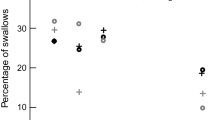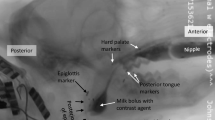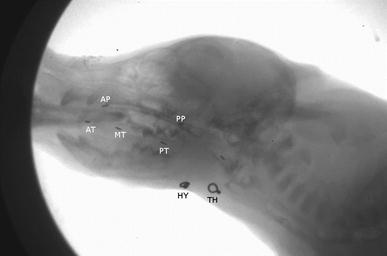Abstract
The timing of the occurrence of a swallow in a respiratory cycle is critical for safe swallowing, and changes with infant development. Infants with damage to the recurrent laryngeal nerve, which receives sensory information from the larynx and supplies the intrinsic muscles of the larynx, experience a significant incidence of dysphagia. Using our validated infant pig model, we determined the interaction between this nerve damage and the coordination between respiration and swallowing during postnatal development. We recorded 23 infant pigs at two ages (neonatal and older, pre-weaning) feeding on milk with barium using simultaneous high-speed videofluoroscopy and measurements of thoracic movement. With a complete linear model, we tested for changes with maturation, and whether these changes are the same in control and lesioned individuals. We found (1) the timing of swallowing and respiration coordination changes with maturation; (2) no overall effect of RLN lesion on the timing of coordination, but (3) a greater magnitude of maturational change occurs with RLN injury. We also determined that animals with no surgical intervention did not differ from animals that had surgery for marker placement and a sham procedure for nerve lesion. The coordination between respiration and swallowing changes in normal, intact individuals to provide increased airway protection prior to weaning. Further, in animals with an RLN lesion, the maturation process has a larger effect. Finally, these results suggest a high level of brainstem sensorimotor interactions with respect to these two functions.




Similar content being viewed by others
References
Abu-Shaweesh JM. Maturation of respiratory reflex responses in the fetus and neonate. Semin Neonatol. 2004;9(3):169–80.
Amaizu N, Shulman R, Schanler R, Lau C. Maturation of oral feeding skills in preterm infants. Acta Paediatr. 2008;97(1):61–7.
Baier DB, Gatesy SM, Dial KP. Three-dimensional, high-resolution skeletal kinematics of the avian wing and shoulder during ascending flapping flight and uphill flap-running. PLoS ONE. 2013;8(5):e63982.
Bautista TG, Xing T, Fong AY, Pilowsky PM. Recurrent laryngeal nerve activity exhibits a 5-HT-mediated long-term facilitation and enhanced response to hypoxia following acute intermittent hypoxia in rat. J Appl Physiol. 2012;112(7):1144–56.
Bautista TG, Dutschmann M. Ponto-medullary nuclei involved in the generation of sequential pharyngeal swallowing and concomitant protective laryngeal adduction in situ. The Journal of physiology. 2014;592(Pt 12):2605–23.
Bautista TG, Fong AY, Dutschmann M. Spontaneous swallowing occurs during autoresuscitation in the in situ brainstem preparation of rat. Respir Physiol Neurobiol. 2014;202C:35–43.
Benjamin JR, Smith PB, Cotten CM, Jaggers J, Goldstein RF, Malcolm WF. Long-term morbidities associated with vocal cord paralysis after surgical closure of a patent ductus arteriosus in extremely low birth weight infants. J Perinatol. 2010;30(6):408–13.
Brainerd EL, Baier DB, Gatesy SM, Hedrick TL, Metzger KA, Gilbert SL, Crisco JJ. X-ray reconstruction of moving morphology (XROMM): precision, accuracy and applications in comparative biomechanics research. J Exp Zool A Ecol Genet Physiol. 2010;313(5):262–79.
Caminita F, van der Merwe M, Hance B, Krishnan R, Miller S, Buddington K, Buddington RK. A preterm pig model of lung immaturity and spontaneous infant respiratory distress syndrome. Am J Physiol Lung Cell Mol Physiol. 2015;308(2):L118–29.
Collaco JM, Aherrera AD, Au Yeung KJ, Lefton-Greif MA, Hoch J, Skinner ML. Interdisciplinary pediatric aerodigestive care and reduction in health care costs and burden. JAMA Otolaryngol Head Neck Surg. 2015;141(2):101–5.
Crompton AW, Thexton AJ, German RZ. Development of the movement of the epiglottis in infant and juvenile pigs. Zoology. 2008;111:339–49.
Daya H, Hosni A, Bejar-Solar I, Evans JN, Bailey CM. Pediatric vocal fold paralysis: a long-term retrospective study. Arch Otolaryngol Head Neck Surg. 2000;126(1):21–5.
Ding P, Campbell-Malone R, Holman SD, Lukasik SL, Fukuhara T, Gierbolini-Norat EM, Thexton AJ, German RZ. Unilateral superior laryngeal nerve lesion in an animal model of Dysphagia and its effect on sucking and swallowing. Dysphagia. 2013;28:404.
Ding P, Campbell-Malone R, Holman SD, Lukasik SL, Thexton AJ, German RZ. The effect of unilateral superior laryngeal nerve lesion on swallowing threshold volume. Laryngoscope. 2013;123(8):1942–7.
Ding P, Fung GS, Lin M, Holman SD, German RZ. The effect of bilateral superior laryngeal nerve lesion on swallowing: a novel method to quantitate aspirated volume and pharyngeal threshold in videofluoroscopy. Dysphagia. 2015;30(1):47–56.
Evans N. Preterm patent ductus arteriosus: a continuing conundrum for the neonatologist? Semin Fetal Neonatal Med. 2015;20(4):272–7.
Feldman JL. Chapter 14–looking forward to breathing. In: Progress in brain research, 2011. 188: p. 213–8.
Franks HA, German RZ, Crompton AW, Hiiemae KM. Mechanism of intra-oral transport in a herbivore, the hyrax (Procavia syriacus). Arch Oral Biol. 1985;30(7):539–44.
Fregosi RF, Ludlow CL. Activation of upper airway muscles during breathing and swallowing. J Appl Physiol. 2014;116(3):291–301.
German RZ, Franks HA. Timing in the movement of jaws, tongue, and hyoid during feeding in the hyrax, Procavia syriacus. J Exp Zool. 1991;257(1):34–42.
German RZ, Crompton AW, Levitch LC, Thexton AJ. The mechanism of suckling in two species of infant mammal: miniature pigs and long-tailed macaques. J Exp Zool. 1992;261:322–30.
German RZ, Crompton AW. Ontogeny of suckling mechanisms in opossums (Didelphis virginiana). Brain Behav Evol. 1996;48(3):157–64.
German RZ, Crompton AW, McCluskey C, Thexton AJ. Coordination between respiration and deglutition in a preterm infant mammal, Sus scrofa. Arch Oral Biol. 1996;41(6):619–22.
German RZ, Crompton AW, Thexton AJ. The coordination and interaction between respiration and deglutition in young pigs. J Comp Physiol. 1998;182:539–47.
German RZ, Crompton AW. The ontogeny of feeding in mammals. In: Schwenk K, editor. Feeding: form, function and evolution in tetrapod vertebrates. San Diego: Academic Press; 2000. p. 449–57.
German RZ, Crompton AW, Thexton AJ. Integration of the reflex pharyngeal swallow into rhythmic oral activity in a neurologically intact pig model. J Neurophysiol. 2009;102(2):1017–25.
German RZ, Campbell-Malone R, Crompton AW, Ding P, Holman S, Konow N, Thexton AJ. The concept of hyoid posture. Dysphagia. 2011;26(2):97–8.
German RZ, Crompton AW, Gould FD, Thexton AJ. Animal models for Dysphagia studies: what have we learnt so far. Dysphagia. 2017;32(1):73–7.
Gewolb IH, Vice FL. Maturational changes in the rhythms, patterning, and coordination of respiration and swallow during feeding in preterm and term infants. Dev Med Child Neurol. 2006;48(7):589–94.
Gidmark NJ, Staab KL, Brainerd EL, Hernandez LP. Flexibility in starting posture drives flexibility in kinematic behavior of the kinethmoid-mediated premaxillary protrusion mechanism in a cyprinid fish, Cyprinus carpio. J Exp Biol. 2012;215(Pt 13):2262–72.
Gierbolini-Norat E, Holman S, Ding P, Bakshi S, German R. Variation in the timing and frequency of sucking and swallowing over an entire feeding session in the infant pig Sus scrofa. Dysphagia. 2014;29:1–8.
Gould FD, Lammers AR, Ohlemacher J, Ballester A, Fraley L, Gross A, German RZ. The physiologic impact of unilateral recurrent laryngeal nerve (RLN) lesion on infant oropharyngeal and esophageal performance. Dysphagia. 2015;30(6):714–22.
Gould FD, Ohlemacher J, Lammers AR, Gross A, Ballester A, Fraley L, German RZ. Central nervous system integration of sensorimotor signals in oral and pharyngeal structures: oropharyngeal kinematics response to recurrent laryngeal nerve lesion. J Appl Physiol. 2016;120(5):495–502.
Gould FDH, Yglesias B, Ohlemacher J, German RZ. Pre-pharyngeal swallow effects of recurrent laryngeal nerve lesion on bolus shape and airway protection in an infant pig model. Dysphagia. 2017;32(3):362–73.
Greer JJ. Control of breathing activity in the fetus and newborn. Compr Physiol. 2012;2(3):1873–88.
Helm JW, German RZ. The epigenetic impact of weaning on craniofacial morphology during growth. J Exp Zool. 1996;276(4):243–53.
Hernandez-Morato I, Valderrama-Canales FJ, Berdugo G, Arias G, McHanwell S, Sanudo J, Vazquez T, Pascual-Font A. Reorganization of laryngeal motoneurons after crush injury in the recurrent laryngeal nerve of the rat. J Anat. 2013;222(4):451–61.
Holman SD, Campbell-Malone R, Ding P, Gierbolini-Norat EM, Lukasik SL, Waranch DR, German RZ. Swallowing kinematics and airway protection after palatal local anesthesia in infant pigs. Laryngoscope. 2013;124:436.
Holman SD, Waranch DR, Campbell-Malone R, Ding P, Gierbolini-Norat EM, Lukasik SL, German RZ. Sucking and swallowing rates after palatal anesthesia: an electromyographic study in infant pigs. J Neurophysiol. 2013;110(2):387–96.
Jadcherla SR, Gupta A, Coley BD, Fernandez S, Shaker R. Esophago-glottal closure reflex in human infants: a novel reflex elicited with concurrent manometry and ultrasonography. Am J Gastroenterol. 2007;102(10):2286–93.
Jadcherla SR, Gupta A, Wang M, Coley BD, Fernandez S, Shaker R. Definition and implications of novel pharyngo-glottal reflex in human infants using concurrent manometry ultrasonography. Am J Gastroenterol. 2009;104(10):2572–82.
Kang SL, Samsudin S, Kuruvilla M, Dhelaria A, Kent S, Kelsall WA. Outcome of patent ductus arteriosus ligation in premature infants in the East of England: a prospective cohort study. Cardiol Young. 2013;23(5):711–6.
Kelly BN, Huckabee M-L, Jones RD, Frampton CMA. The first year of human life: coordinating respiration and nutritive swallowing. Dysphagia. 2007;22:37–43.
Knight MJ, McDonald SE, Birchall MA. Intrinsic muscles and distribution of the recurrent laryngeal nerve in the pig larynx. Eur Arch Otorhinolaryngol. 2005;262(4):281–5.
Kupfer RA, Callaghan BC, Hogikyan ND. Neurogenic vocal fold motion impairment after routine intubation for tonsillectomy in a pediatric patient. J Voice. 2014;28(1):112–4.
Laitman JT, Reidenberg JS. The evolution and development of human swallowing: the most important function we least appreciate. Otolaryngol Clin N Am. 2013;46(6):923–35.
Lau C, Alagugurusamy R, Schanler RJ, Smith EO, Shulman RJ. Characterization of the developmental stages of sucking in preterm infants during bottle feeding. Acta Paediatr. 2000;89(7):846–52.
Lau C, Smith EO, Schanler RJ. Coordination of suck-swallow and swallow respiration in preterm infants. Acta Paediatr. 2003;92(6):721–7.
Lau C, Geddes D, Mizuno K, Schaal B. The development of oral feeding skills in infants. Int J Pediatr. 2012;2012:572341.
Lefton-Greif MA, Loughlin GM. Specialized studies in pediatric dysphagia. Semin Speech Lang. 1996;17(4):311–29.
Lefton-Greif MA, Arvedson JC. Pediatric feeding and swallowing disorders: state of health, population trends, and application of the international classification of functioning, disability, and health. Semin Speech Lang. 2007;28(3):161–5.
Lefton-Greif MA, Okelo SO, Wright JM, Collaco JM, McGrath-Morrow SA, Eakin MN. Impact of children’s feeding/swallowing problems: validation of a new caregiver instrument. Dysphagia. 2014;29(6):671–7.
Matsuo K, Palmer JB. Anatomy and physiology of feeding and swallowing: normal and abnormal. Phys Med Rehabil Clin N Am. 2008;19(4):691–707.
Mortellaro VE, Pettiford JN, St Peter SD, Fraser JD, Ho B, Wei J. Incidence, diagnosis, and outcomes of vocal fold immobility after esophageal atresia (EA) and/or tracheoesophageal fistula (TEF) repair. Eur J Pediatr Surg. 2011;21(6):386–8.
Paniello RC. Vocal fold paralysis: improved adductor recovery by vincristine blockade of posterior cricoarytenoid. Laryngoscope. 2014;125:655.
Paniello RC, Rich JT, Debnath NL. Laryngeal adductor function in experimental models of recurrent laryngeal nerve injury. Laryngoscope. 2014;125:E67.
da Pereira KR, Firpo C, Gasparin M, Teixeira AR, Dornelles S, Bacaltchuk T, Levy DS. Evaluation of swallowing in infants with congenital heart defect. Int Arch Otorhinolaryngol. 2015;19(1):55–60.
Pourmoghadam KK, DeCampli WM, Ruzmetov M, Kosko J, Kishawi S, O’Brien M, Cowden A, Piggott K, Fakioglu H. Recurrent laryngeal nerve injury and swallowing dysfunction in neonatal aortic arch repair. Ann Thorac Surg. 2017;104(5):1611–8.
Prakash M, Johnny JC. Whats special in a child’s larynx? J Pharm Bioallied Sci. 2015;7(Suppl 1):S55–8.
Rasch S, Sangild PT, Gregersen H, Schmidt M, Omari T, Lau C. The preterm piglet—a model in the study of oesophageal development in preterm neonates. Acta Paediatr. 2010;99(2):201–8.
Rommel N, van Wijk M, Boets B, Hebbard G, Haslam R, Davidson G, Omari T. Development of pharyngo-esophageal physiology during swallowing in the preterm infant. Neurogastroenterol Motil. 2011;23(10):e401–8.
Sachdeva R, Hussain E, Moss MM, Schmitz ML, Ray RM, Imamura M, Jaquiss RD. Vocal cord dysfunction and feeding difficulties after pediatric cardiovascular surgery. J Pediatr. 2007;151(3):312–5.
Sangild PT, Thymann T, Schmidt M, Stoll B, Burrin DG, Buddington RK. Invited review: the preterm pig as a model in pediatric gastroenterology. J Anim Sci. 2013;91(10):4713–29.
Tessema B, Roark RM, Pitman MJ, Weissbrod P, Sharma S, Schaefer SD. Observations of recurrent laryngeal nerve injury and recovery using a rat model. Laryngoscope. 2009;119(8):1644–51.
Thexton AJ, Crompton AW, German RZ. Transition from suckling to drinking at weaning: a kinematic and electromyographic study in miniature pigs. J Exp Zool. 1998;280(5):327–43.
Thexton AJ, Crompton AW, Owerkowicz T, German RZ. Correlation between intraoral pressures and tongue movements in the suckling pig. Arch Oral Biol. 2004;49(7):567–75.
Thexton AJ, Crompton AW, German RZ. Electromyographic activity during the reflex pharyngeal swallow in the pig: Doty and Bosma (1956) revisited. J Appl Physiol. 2007;102(2):587–600.
Thexton AJ, Crompton AW, Owerkowicz T, German RZ. Impact of rhythmic oral activity on the timing of muscle activation in the swallow of the decerebrate pig. J Neurophysiol. 2009;101(3):1386–93.
Tucker AL, Duncan IJ, Millman ST, Friendship RM, Widowski TM. The effect of dentition on feeding development in piglets and on their growth and behavior after weaning. J Anim Sci. 2010;88(7):2277–88.
Tutor JD, Gosa MM. Dysphagia and aspiration in children. Pediatr Pulmonol. 2012;47(4):321–37.
Acknowledgements
The Authors thank the CMU at NEOMED for their extensive support of this project.
Funding
This study was funded by NIH 1R01HD088561 to RZG.
Author information
Authors and Affiliations
Corresponding author
Ethics declarations
Conflict of interest
All authors declare they have no conflict of interest.
Ethical Approval
All applicable international, national, and/or institutional guidelines for the care and use of animals were followed, and was done in accordance with NEOMED IACUC approval, protocol #17-04-071.
Rights and permissions
About this article
Cite this article
Ballester, A., Gould, F., Bond, L. et al. Maturation of the Coordination Between Respiration and Deglutition with and Without Recurrent Laryngeal Nerve Lesion in an Animal Model. Dysphagia 33, 627–635 (2018). https://doi.org/10.1007/s00455-018-9881-z
Received:
Accepted:
Published:
Issue Date:
DOI: https://doi.org/10.1007/s00455-018-9881-z




